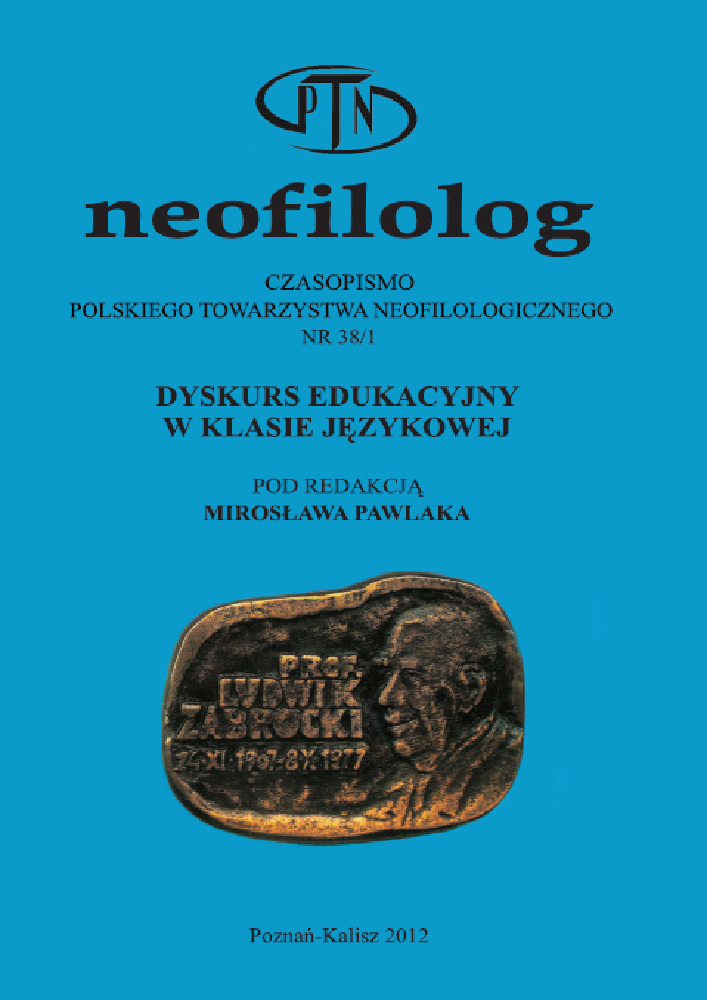Abstrakt
According to numerous theorists and researchers, negotiation of form and meaning plays a crucial role in second and foreign language acquisition, since it enhances the quality of the input to which learners are exposed, it promotes noticing gaps and holes in their target language knowledge, and it provides them with opportunities to modify their incorrect output. Such advantages have been posited, among others, by the Noticing Hypothesis (Schmidt, 1990), the Interaction Hypothesis (Long, 1996) and the Output Hypothesis (Swain, 1995), and they have corroborated by the latest findings of research seeking to determine the value of different focus-on-form options and in particular different ways of providing corrective feedback (Sheen i Ellis, 2011; Pawlak, 2012). It can thus be assumed that teachers should stimulate the use of negotiation, either by reacting in the right way to learners' problematic utterances, planning communicative tasks encouraging its use, or undertaking training in this area. In line with such reasoning, the aim of this paper is to report the results of a study which attempted to determine the incidence of negotiated interaction in pair and group work activities, and to appraise its value for language acquisition.
Bibliografia
Canale, M. 1983. „From communicative competence to communicative language pedagogy", [w:] Richards, J. C. i Schmidt, R. W. (red.). Language and communication. London: Longman. 2-27.
Canale, M. i Swain, M. 1980. „Theoretical bases of communicative approaches to second language teaching and testing", [w:] Applied Linguistics 1: 1-47.
Dörnyei, Z. 1995. „On the teachability of communication strategies", [w:] TESOL Quarterly 29: 55-85.
Ellis, R. 1999. „Theoretical perspectives on interaction and language learning", [w:] Ellis, R. (red.). Learning a second language through interaction. Amsterdam: John Benjamins. 3-32.
Ellis, R., Basturkmen, H. i Loewen, S. 2001. „Learner uptake in communicative ESL lessons", [w:] Language Learning 51: 281-318.
Ellis, R., Basturkmen, H. i Loewen, S. 2002. „Doing focus on form", [w:] System 30:419-432.
Foster, P. 1998. „A classroom perspective on the negotiation of meaning", [w:] Applied Linguistics 19: 1 -23.
Gass, S. M. 2003. „Input and interaction", [w:] Doughty, C. J. i Long, M. H. (red.). The handbook of second language acquisition. Oxford: Blackwell. 224-255.
Hatch, E. (ed.). 1978. Second language acquisition: A book of readings. Rowley, MA: Newbury House.
Krashen, S. D. 1982. Principles and practice in second language acquisition. New York: Prentice Hall.
Krashen, S. D. 1985. The input hypothesis. London: Longman.
Lantolf, J. P. 2006. „Sociocultural Theory and L2: State of the art", [w:] Studies in Second Language Acquisition 28: 67-109.
Lantolf, J. P. i Thorne, S. L. 2006. Sociocultural Theory and the genesis of second language development. Oxford: Oxford University Press.
Long, M. H. 1983. „Native speaker/non-native speaker conversation and the negotiation of comprehensible input", [w:] Applied Linguistics 4: 126-141.
Long, M. H. 1996. „The role of the linguistic environment in second language acquisition", [w:] Ritchie, W. i Bhatia, T. (red.). Handbook of research on second language acquisition. New York: Academic Press. 413-468.
Loschky, L. 1994. „Comprehensible input and second language acquisition: What is the relationship?" [w:] Studies in Second Language Acquisition 16: 303-24.
Lyster, R. i Saito, K. 2010. „Oral feedback in classroom SLA: A meta-analysis", [w:] Studies in S econd Language Acquisition 32: 265-302.
Pawlak, M. 2005. „The feasibility of integrating form and meaning in the language classroom: A qualitative study of classroom discourse", [w:] Glottodidactica 30/31: 283-294.
Pawlak, M. 2006. „On the incidence and effect of negotiation of form and meaning in group work activities: Contrasting theoretical claims with classroom reality", [w:] IATEFL Research News 18: 31-35.
Pawlak, M. 2012. Error correction in the foreign language classroom: Keconsidenng the issues. Poznań — Kalisz — Konin: Wydawnictwo UAM i PWSZ w Koninie.
Pica, T. 1987. „Second language acquisition, social interaction, and the classroom", [w:] Applied Linguistics 8: 3-21.
Schmidt, R. 1990. „The role of consciousness in second language learning", [w:] Applied Linguistics 11:17-46.
Seliger, H. 1983. „Learner interaction in the classroom and its effect on language acquisition", [w:] Seliger, H. i Long, M. H. (red.). Classroom-oriented research in second language acquisition. Rowley, MA: Newbury House. 246-66.
Sheen, Y. 2004. „Corrective feedback and learner uptake in communicative classrooms across instructional contexts", [w:] Language Teaching Research 8: 263-300.
Sheen, Y. i Ellis, R. 2011. „Corrective feedback in language teaching", [w:] Hinkel, E. (red.). Handbook of research in second language teaching and learning. Volume II. New York and London: Routledge. 593-610.
Swain, M. 1985. „Communicative competence: Some roles of comprehensible input and comprehensible output in its development", [w:] Gass, S. M. i Madden, C. G. (red.). Input in second language acquisition. Rowley, MA: Newbury House. 235-253.
Swain, M. 1995. „Three functions of output in second language learning", [w:] Cook, G. i Seidlhofer, B. (red). Pńnciples and practice in applied linguistics. Studies in honor of H. G. Widdovuson. Oxford: Oxford University Press. 125-144.
Swain, M. 2000. „The output hypothesis and beyond: Mediating acquisition through collaborative dialogue", [w:] Lantolf, J. P. (red.). S o do cultural theory and second language learning. Oxford: Oxford University Press. 97-114.
Swain, M. 2005. „The output hypothesis: Theory and research", [w:] Hinkel, E. (red.). Handbook of research in second language teaching and learning. Mahwah, NJ: Lawrence Erlbaum. 471-483.
Tanaka, Y. 1991. „Comprehension and L2 acquisition: the role of interaction". Niepublikowany manuskrypt, Tokyo: Temple University Japan.
Licencja
Prawa autorskie (c) 1970 Mirosław Pawlak

Utwór dostępny jest na licencji Creative Commons Uznanie autorstwa – Bez utworów zależnych 4.0 Międzynarodowe.
Przedstawiany utwór (artykuł) upubliczniany jest na podstawie umowy z autorem i na licencji Creative Commons Attribution-NoDerivatives 4.0 International (CC BY-ND 4.0).
Użytkownicy mają obowiązek podania wraz z rozpowszechnionym utworem, informacji o autorstwie, tytule, źródle (odnośniki do oryginalnego utworu, DOI) oraz samej licencji;
- bez tworzenia utworów zależnych,
- utwór musi być zachowany w oryginalnej postaci.
Uniwersytet im. Adama Mickiewicza w Poznaniu zachowuje prawo do czasopisma jako całości (układ, forma graficzna, tytuł, projekt okładki, logo itp.).
